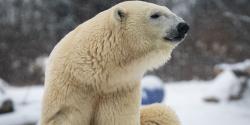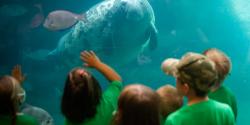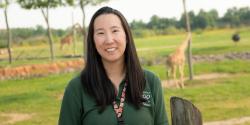The unmistakable warning of the eastern massasauga rattlesnake, that signature rattle, is often feared, but rarely understood. To many, snakes symbolize danger, yet these remarkable reptiles play an essential role in maintaining Ohio’s ecosystems. Massasaugas are shy and secretive, spending most of their lives hidden amongst tall grasses or basking quietly in the sun, preferring to avoid confrontation whenever possible.
The name Massasauaga comes from a Chippewa word meaning “great river mouth,” which is fitting for a snake that calls Ohio’s dwindling prairies and wetlands home.
As both predator and prey, massasauga’s help keep nature in balance by controlling rodent populations and providing food for wildlife, such as hawks and herons, which help to maintain a healthy prairie ecosystem. Once widespread across Ohio, the eastern massasauga is now listed as endangered in Ohio, and threatened throughout their U.S. range, under the Endangered Species Act. The biggest threats massasaugas face today come from development, wetland destruction, and invasive plants taking over their habitats. Without ongoing conservation efforts, they are in danger of becoming another casualty of biodiversity loss.
At Columbus Zoo and Aquarium, we are proud to be a part of a critical effort to preserve the eastern massasauga rattlesnake through breeding, education, and conservation. The Zoo participates in the Association of Zoos and Aquariums’ (AZA) Eastern Massasauaga Rattlesnake SAFE (Saving Animals From Extinction) program, an international collaborative effort between multiple institutions to protect and support the long-term survival of this species.

"The reptile team is actively preparing for breeding efforts and is excited about the future of this important conservation initiative. Due to our expertise and strong history of fieldwork and venomous snake care, the Zoo was chosen as one of only five designated breeding centers for the species,” said Taylor Hann, Assistant Curator of the Columbus Zoo’s Shores and Aquarium region. “While we are just one part of a larger network of dedicated institutions, our role in SAFE allows us to directly contribute to the recovery and ongoing survival of this threatened species.”
This summer, our field team wrapped up another successful season at Killdeer Plains Wildlife Area, where they’ve been tracking and monitoring wild massasaugas as part of a multi-year conservation effort. The focus is on locating gravid (pregnant) females for safe relocation to a southwest Ohio preserve, in what is the state’s first attempt to rescue a population that is dwindling and inbred due to such few numbers.
While the 2025 field season presented some challenges, persistence paid off. Three females were successfully transported to the Zoo for ultrasounds and health checks with Dr. Priya Bapodra-Villaverde before being translocated to their new home where they gave birth to 23 healthy neonates. Combined with the previous year’s 35 young, that’s a growing new generation of rattlesnakes born safely in their native range.
The team’s efforts are already showing promising signs of success. Several of the young snakes released last year were found this season, proof that they made it through the winter and are thriving in their new home. Even more exciting, this year’s newborns have been spotted on specially-designed cameras in place in the preserve, a hopeful sign that the next generation is settling in well.
Protecting these snakes isn’t just about saving this single species. Massasaugas rely on sunlit areas dominated by herbaceous (non-woody) vegetation. Species that live in these habitats dominate lists of declining and imperiled wildlife, from rare orchids to grassland birds, butterflies, and bees. Ensuring the continued survival of the massasauga will undoubtedly benefit a range of species. Through dedication, innovation, and collaboration, the Columbus Zoo and Aquarium is proud to play a role in giving these snakes a brighter, more stable future.









